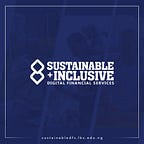Financial Inclusion in Rural Nigeria (CICO Economics)
Challenges facing agent business viability
In the quest to extend financial services to the unbanked, particularly those in remote and underserved (rural) regions, it is critical that we discuss the viability of agents. Agents are retail store front operators representing financial services providers with the delivery of financial services. It is envisaged that agents are members of the local communities and already engaged in some form of retail trade — operating a kiosk, supermarket or other type of business.
According to EFinA’s 2018 Access to Finance Survey, financial exclusion is highest primarily in rural areas. This is because the traditional model of delivering financial services — aka the bank branch — is not sustainable in these areas. Most times, the profits gotten from remote areas are not enough to offset the cost of setting up and running a bank branch in these areas.
In the quest to explore cheaper and sustainable alternatives, in 2013, the CBN introduced the agent banking guidelines which permitted financial institutions and MMOs to appoint third parties as agents to provide financial services on their behalf to members of the public. The CBN’s regulatory framework also includes a super-agent framework, responsible for monitoring and supervising the activities of agents, including the volume and value of transactions for each type of service they offer.
In spite of these developments, there have been challenges in scaling agent business across the country. In 2018, we set out to understand the economics of the mobile money agent channel.
Some of the revelations from our study include:
1. Rural is not homogeneous
According to the World Bank, about 51.4 percent of Nigeria’s population lives in rural areas. Within these rural areas, there are distinctions we have labelled as the rural oases and the rural frontiers.
The rural oases are locations in proximity to economic activity such as markets and bus parks. These locations are considered “potentially viable” due to the aggregation of people and other factors including but not limited to moderate DFS penetration and the existence of infrastructure like power, paved roads and mobile connectivity. On the other hand, the rural frontier refers to areas which are scarcely populated, have limited DFS penetration, experience minimal economic activity and also lack adequate infrastructure.
2. Agent viability varies tremendously across the country
We discovered that, even within rural regions, due to the presence / absence of several features, agent viability varies significantly across the identified regions.
For the rural oases, agent viability is high due to the presence of / proximity to regions of high economic activity. We found that agents in these regions are usually located near markets, village centers, busy streets etc. The moderate DFS penetration and presence of critical infrastructure (e.g. bank presence, paved roads, power and mobile connectivity) also increase the chances of viability for agents to do their business.
The reverse is the case for the rural frontiers. The absence of those enabling features — DFS, low economic activity, limited infrastructure — limits the profitability of agent business.
Based on our report, we concluded that “while CICO economics are viable today in urban, peri-urban and rural “oases”, we reach the limits to CICO viability as we enter the rural frontier.” Indeed, for providers, agent point economics are favorable in areas with sufficient transactions and revenue with viability dropping the further into rural frontiers the agent business ventures.
3. Provider and agent economics
The difficulty faced by agents and providers in remaining viable rests primarily on transaction volume and revenue. Volume and revenue tend to reduce the farther out into the rural frontiers agent businesses are situated. The absence of infrastructure provisions such as power, mobile network connectivity etc, most of which are fundamental to the delivery of financial services, also has a significant negative impact on the viability of agent business in these identified regions.
4. The potential for scale is limited
The question of the attainment of 80 percent inclusion by 2020 comes up again, even as preliminary modeling suggests that using the current agent model, agent services could scale to reach, at most, 51 percent of Nigeria’s adult population.
How did we arrive at this number? By layering the viability of agent business in the different regions of Nigeria over the geospatial distribution of requisite infrastructure for financial inclusion (such as mobile network connectivity, electricity supply, bank infrastructure etc), the results reveal that 51 percent of Nigeria’s adult population today lives in agent-viable areas.
That would leave a sizeable number still without financial access.
Interventions
Our financial inclusion aspirations requires an extensive agent network. However, viability at the scale we desire will be elusive without proper interventions.
- In particular, infrastructure provisions which are the rails enabling financial access and usage need to be prioritised in order to improve the viability of some areas. Allocation of resources to improve mobile network connectivity, electricity supply, and even bank presence (for rebalancing) are required.
- As a for-profit venture, agent business in the rural frontier still offers a poor business case for entrepreneurs and private enterprise. We may therefore need to introduce subsidy facilities for agents / providers, if they’re going to extend their services to the rural frontiers.
- Further expansion would require other interventions e.g. digitization of G2P, float runners and so on. These are conversations which stakeholders need to come together to have in order to produce realistic and sustainable ideas.
Conclusion
It is admirable that the National Financial inclusion Strategy hopes to bring financial access to 80 percent of the adult population. However, the lack of infrastructure and other utilities which are critical to the delivery of financial services at the last mile, suggest that the road ahead may be tougher than we assumed.
Download and read the full CICO Economics report here.
